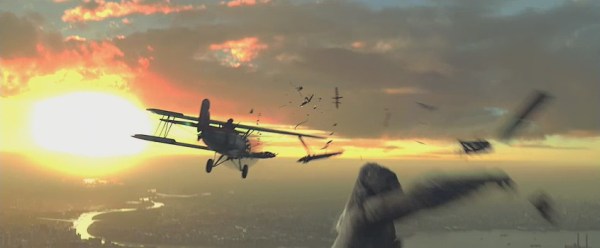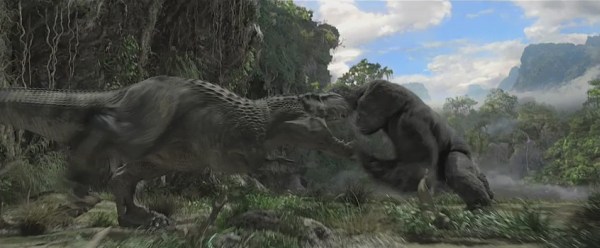Peter Jackson’s remake of King Kong has certain quarters of the internet abuzz with anticipation. Which is only natural: Jackson is coming off an epic project that won both critical and audience acclaim, and moving on to a reworking of a much-loved classic. Sources such as Ain’t It Cool have been at their most openly slavering. (Here’s an Ain’t It Cool quote for the poster: “I am bonerized.“) This is the kind of “this is going to be huge” internet buzz that most other productions can only dream of. The producers of the remade Poseidon Adventure, for example, have engaged in an elaborate process of set visits for the biggest on-line movie sites that has resulted in series of dutifully impressed articles, but little of the genuine excitement that some of the fan community show for Kong.
This excitement, however, has derived almost entirely from the match of director and project: the actual material that has been released publicly so far was not terribly impressive. The initial teaser trailer (here) was big on Jurassic Park style dinosaurs, but left many (including myself) relatively unimpressed. The second trailer, which hit the internet last week (here), unveiled a redesigned Kong (much older and more grizzled than in the teaser, and without the goofy looking projecting tooth), and was considerably better. However, it still raised the issue: how on earth does anyone make this material fresh?
The problem derives from the influential material: we have seen a flood of Kong derivatives over the last decade. This is actually an unusual situation, in a historical sense: the original 1933 King Kong is a primary source for modern special effects cinema, but for many years there were relatively few imitations of it. In particular, the stop-motion animation techniques used to realise its creatures remained so fiddly and unrealistic that they remained used in only a small number of films. The list of notable stop motion artists is very short: Willis O’Brien (who did the original Kong, as well as 1925’s The Lost World and 1949’s Mighty Joe Young); Ray Harryhausen (Jason & The Argonauts and The 7th Voyage of Sinbad); and Phil Tippett (the original Star Wars films, Dragonslayer, and Jurassic Park) are really the only notable figures, and these three between them provided effects for most of the really notable animated creature movies before the 1990s. By that decade, stop-motion had largely been abandoned by Hollywood productions: the inherent limitations of the technique did not yield a realistic enough approach. (Even the first remake of King Kong, in 1976, spurned stop-motion in favour of simple man-in-suit effects).
In 1993, however, Jurassic Park opened the floodgates. Phil Tippett was hired for that production, with the intent of producing the dinosaurs through an advanced variant of stop-motion (nicknamed “go-motion”) that he had pioneered on The Empire Strikes Back. However, advances in computer graphics meant that go-motion was abandoned early in the production, and the resulting breakthroughs in computer animation completely revolutionised the field. The Jurassic Park computer-generated dinosaurs were a leap ahead not only for their improved realism, but for their much more seamless integration into live action footage. This made fully animated creatures much more feasible, and the cinemas have been full of creature heavy films ever since, with The Lost World, Starship Troopers, Godzilla, Attack of the Clones, and all of the The Lord of the Rings and Harry Potter films, amongst many others. The 1933 King Kong was a crucial inspiration for all these films, with some building on it very directly. The structure of Spielberg’s The Lost World, for example, is a straight steal from Kong, with two thirds of both films spent on an island filled with exotic dinosaurs, followed by a final sequence in which one of these creatures wreaks havoc in a city.
This debt to Kong is central to the appeal of the remake, but it is also a problem: we have seen an awful lot of films featuring people running around being chased by computer generated monsters recently. I think this explains why, despite the in-principle excitement about the new King Kong, the reaction to the trailers themselves has been so lukewarm.
Perhaps it is for this reason that the distributors wanted to show off some of the footage from the new movie to critics and exhibitors. The centrepiece of the presentation was a fifteen minute sequence form the central portion of the movie, when Ann Darrow (Naomi Watts) has been captured by Kong, and flees from him into the jungle. The sequence is a classic exercise in escalation: Darrow encounters a series of increasingly oversized beasts as she tries to escape, starting with mosquitoes the size of her hand, followed by metre-long centipedes and a pair of lizard-like dinosaurs (or possibly just giant lizards – if you can tell the difference, please let me know). Finally, she stumbles into the path of three T-Rexes, from which she is rescued by Kong in a considerably enhanced version of a similar showdown in the original film.
The sequence was still pretty unfinished, with some scenes (particularly at the start and end of the sequence) still barely more than animatics. However, enough of the key shots were there to show that technically the effects look to be top notch. This is not something to be taken for granted: the sheer quantity of computer-generated effects being produced lately has meant that the both the quality of animation and realism of shots in many of these films has suffered. (The new Star Wars films, for example, have been particularly notable offenders in this regard). While I suspect any project as large as Kong will end up with a few ropey shots, the material shown suggests that the key sequences at least should generally look pretty good. Certainly Jackson is using the best people: the people at Weta Digital who are working on Kong also did the work on Gollum in The Two Towers and Return of the King, which is far and away the most impressive animated character in the current cycle of computer animated films.
Perhaps more impressive, however, is that in this sequence Jackson manages to beat the law of diminishing returns. As we have seen more and more of this kind of movie, each of which tries to top the last, we have seen the effects become increasingly elaborate. The stampedes of creatures become grander and the action becomes more hyperbolic, even as audiences become progressively more jaded. The Kong vs T-Rex sequence responds to this kind of escalation by revelling in its own sheer outrageousness. The climax of the sequence shows Kong, the dinosaurs and Darrow falling over a cliff and becoming entangled in a series of hanging vines. The fight then continues mid-air as the dinosaurs try to swing and catch Darrow, with Kong fighting them off. It is, frankly, a ridiculous notion. Jackson gets away with it, however, because he recognises that the sequence’s outlandishness brings its own inherent humour. As computer effects sequences become ever more over-the-top, such a lightness of touch is vital.
The other small detail that I liked was a very direct reference to the 1933 King Kong. The sequence finishes with a one-on-one fight, with Kong and one T-Rex falling to the ground and facing each other off for Darrow. (This is the moment shown prominently in both trailers, which I had wrongly assumed comes from the start of the sequence. In fact, it is near the end, with Kong dropping to the ground after hanging from the vines: this is why Kong appears so dramatically from the top of screen in the trailer). This final stage of the fight is a very close recreation of the equivalent scene in the original, and it finishes with Kong quizzically opening and closing the now-limp jaws of the slain T-Rex. It’s a nice little moment of animation, adding crucial personality to Kong, but it’s also an acknowledgement of Willis O’Brien’s work on the original: Kong did exactly the same thing in 1933.
So while I won’t say that I’m “bonerized,” I can say that I now look forward to Jackson’s King Kong with considerably expanded expectations.
This piece was originally published on In Film Australia.

